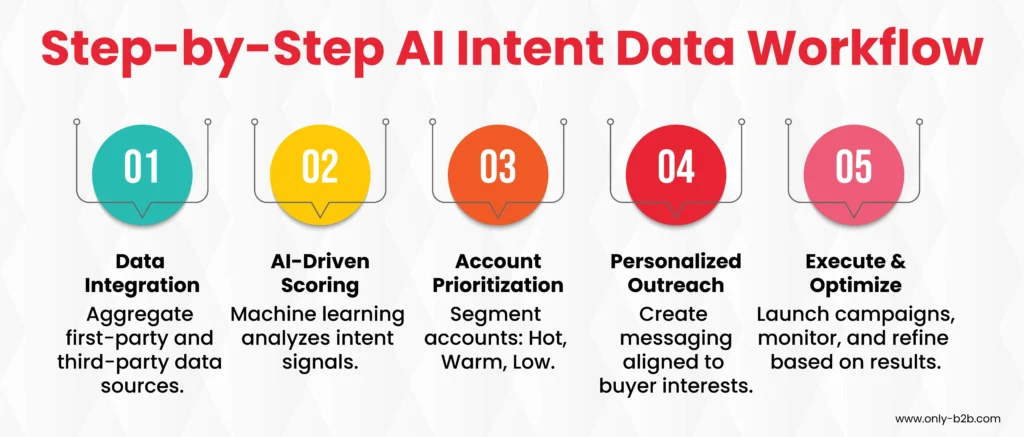A 1–2% response rate doesn’t justify the efforts you put into crafting a targeted outbound campaign, does it not?
Your marketing and sales teams are working harder, sending thousands of emails and LinkedIn messages. Yet, the response rate is poor.
But the thing is, more messages aren’t yielding more meetings. They’re only creating more noise.

This is where B2B intent data plays a key role, helping you identify prospects who are most likely to engage.
At the same time, AI-powered intent data takes it a step further by predicting patterns and buying signals more accurately.
In this guide, we’ll discuss how to leverage AI-driven intent data to transform your outreach strategy from noise into high-impact conversations.
What Is AI‑Powered Intent Data?
Table of Contents
Traditional lead scoring is basically about analysing form-fills, job titles, or basic site visits. It worked once, but is obsolete today.
Why? Because it fails to capture when a buyer is actively evaluating options, leading your team to waste time chasing accounts that aren’t even considering buying.
Genuine intent is revealed by peeling back deeper layers, examining frequency, depth, and type of engagement. AI models help uncover these wafer-thin layers as reliable indicators, helping you prioritize effectively.
It uses machine learning to dissect multiple data signals, both first-party and third-party. It analyzes thousands and thousands of these digital signal footprints in real-time to accurately predict buyer intent.
For example, AI notices that a prospect company has engaged with multiple thought leadership articles on your site, attended a virtual event, and recently followed your brand on LinkedIn.
These combined actions are scored as high intent, prompting your sales team to initiate a conversation while interest is at its peak.
AI-powered intent data is the foundation for top-performing B2B sales and marketing strategies. And over 70% of high-performing B2B organizations rely on AI intent data, and yet 59% plan to expand these efforts further.
Key Benefits of Using AI-Powered Intent Data
Implementing AI-powered intent data offers several clear benefits for your B2B outreach. Here’s what your team can expect when using AI intent insights:
Addressing Conversion Frustration
AI intent data pinpoints prospects who are actively researching solutions like yours. This way, your teams to focus on opportunities with a much higher likelihood of moving forward.
This not only shortens sales cycles but also ensures your efforts are concentrated where they deliver the greatest return.
Improved Response and Conversion Rates
With AI-driven intent signals, you can achieve two to three times higher response rates compared to traditional outreach. Because now your messaging is informed by what prospects are actually researching, it feels timely, relevant, and personalized.
Enhanced Pipeline Velocity and Cost Efficiency
Many organizations have significantly reduced their cost-per-opportunity, sometimes by over a third, while maintaining or even increasing deal volume. The result is a healthier, faster-moving pipeline that delivers more revenue without requiring more resources.
Step-by-Step Implementation Workflow
To make the most of AI-powered intent data, follow this structured approach for smooth implementation and measurable success:
Step 1: Aggregate Signals from All Sources
Start by consolidating data from every relevant source. First-party signals include your website analytics, CRM records, email engagement metrics, and content interactions.
Then integrate third-party intent signals gathered from external sources, such as prospects’ interactions with industry forums, review sites, competitor pages, and research portals.
Next, bring all these signals together into one centralized platform or dashboard, such as your CRM. This way, you make sure your team has clear visibility.
This approach saves you from fragmented workflows and equips your team with comprehensive insights about account behavior.
Step 2: AI-Powered Scoring
Once you have centralized your data, apply machine learning models to analyze it comprehensively.
AI isn’t limited to simply tallying visits or clicks. It evaluates multiple dimensions, including the timing, diversity, frequency, and intensity of prospect interactions.
For example, repeated visits to your pricing page, feature-comparison content, or ROI calculators will score higher, indicating serious buying intent compared to general browsing or infrequent clicks.
This sophisticated scoring helps your team separate genuine buying signals from casual research or curiosity.
Step 3: Segment and Prioritize Accounts
Next, use AI-generated intent scores to clearly segment your accounts into actionable groups. This prioritization directly informs your outreach strategy:
- Hot accounts: High intent scores combined with an ideal customer profile match. These should immediately receive high-touch, personalized outreach from your sales reps.
- Warm accounts: Show moderate interest or engagement and should be placed into segmented nurturing campaigns, guiding them further along their buying journey.
- Low accounts: Currently showing minimal intent signals. Monitor passively and engage actively only if their activity significantly increases.
This structured approach prevents wasted efforts on accounts unlikely to convert and focuses your resources where the greatest impact is possible.
Step 4: Personalized, Intent-Led Outreach
Now comes the strategic execution. Craft outreach messages that explicitly reference the signals you’ve gathered.
For example, if an account has recently viewed multiple case studies on expense management solutions, your outreach email could start with:
“We noticed your interest in expense management case studies; here’s how we’ve helped companies like yours reduce operational costs.”
By leveraging intent data, you can automatically populate dynamic fields in your email sequences, LinkedIn InMails, or sales scripts.
This makes personalized outreach not just possible, but scalable. The result is messaging that resonates deeply because it aligns precisely with your prospects’ current interests and challenges.
Step 5: Execute, Monitor, and Optimize
Finally, launch your intent-driven outreach campaigns. Immediately begin monitoring critical performance metrics such as response rates, meeting acceptance rates, pipeline velocity, and cost per lead.
Use the insights gained to continuously refine your process. Adjust your scoring thresholds, improve messaging based on what resonates most with your audience, or re-segment accounts based on updated intent signals.
Initial pilots are key. Start by testing this workflow within a specific segment or region. Once you demonstrate success through measurable outcomes, scale this intent-driven approach to the rest of your organization.

Integration Best Practices for Adoption
Successful adoption of AI-powered intent data requires seamless integration into your existing workflows. Follow these best practices to ensure smooth implementation and maximum impact:
Embed Intent Data into CRM Workflows
Ensure intent scores and activity trigger fields are visible in Salesforce, HubSpot, or equivalent. That means reps see intent context directly inside opportunity/account views.
Automate Outreach When Intent Spikes
Link intent signals to platforms like SalesLoft or Outreach. Automate trigger-based sequences so outreach aligns immediately with buyer activity. Delayed outreach undermines relevance.
Preserve Data Quality
Regular audits are essential. Remove stale signals or low-quality data. Trust in the workflow depends on accuracy — poor data diminishes adoption and performance.
Align Teams Around Signals
Shared dashboards and joint marketing-sales reviews ensure everyone acts on the same signals. This keeps outreach timely and avoids missed opportunities.
Choose Integrated Systems
Select providers offering end-to-end integration, intent, CRM, and outreach, to limit manual handoffs and friction in execution.
The Future of B2B Outreach Is Intent‑Driven
Generic outreach methods don’t work anymore. AI-powered intent data gives you the right context, relevance, and timing to connect with prospects when they’re ready to talk.
This means more replies, faster deals, and better results. If you’re ready to move beyond guesswork, make AI-powered intent data the first step of your outreach strategy.

Vikas Bhatt is the Co-Founder of ONLY B2B, a premium B2B lead generation company that specializes in helping businesses achieve their growth objectives through targeted marketing & sales campaigns. With 10+ years of experience in the industry, Vikas has a deep understanding of the challenges faced by businesses today and has developed a unique approach to lead generation that has helped clients across a range of industries around the globe. As a thought leader in the B2B marketing community, ONLY B2B specializes in demand generation, content syndication, database services and more.





